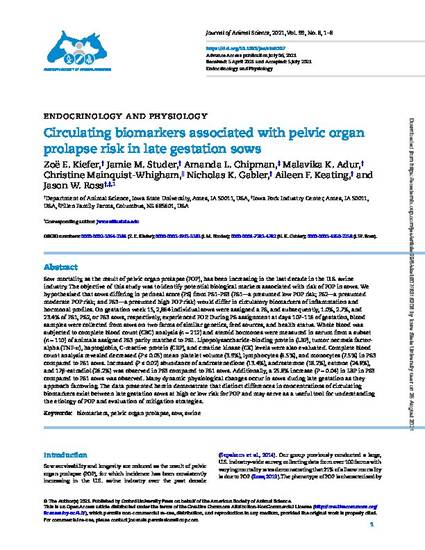
Sow mortality, as the result of pelvic organ prolapse (POP), has been increasing in the last decade in the U.S. swine industry. The objective of this study was to identify potential biological markers associated with risk of POP in sows. We hypothesized that sows differing in perineal score (PS) from PS1–PS3 (PS1—a presumed low POP risk; PS2—a presumed moderate POP risk; and PS3—a presumed high POP risk) would differ in circulatory biomarkers of inflammation and hormonal profiles. On gestation week 15, 2,864 individual sows were assigned a PS, and subsequently, 1.0%, 2.7%, and 23.4% of PS1, PS2, or PS3 sows, respectively, experienced POP. During PS assignment at days 107–116 of gestation, blood samples were collected from sows on two farms of similar genetics, feed sources, and health status. Whole blood was subjected to complete blood count (CBC) analysis (n = 212) and steroid hormones were measured in serum from a subset (n = 110) of animals assigned PS3 parity matched to PS1. Lipopolysaccharide-binding protein (LBP), tumor necrosis factor-alpha (TNF-α), haptoglobin, C-reactive protein (CRP), and creatine kinase (CK) levels were also evaluated. Complete blood count analysis revealed decreased (P ≤ 0.05) mean platelet volume (3.9%), lymphocytes (6.5%), and monocytes (7.5%) in PS3 compared to PS1 sows. Increased (P ≤ 0.02) abundance of androstenedione (13.4%), androsterone (18.2%), estrone (24.8%), and 17β-estradiol (26.2%) was observed in PS3 compared to PS1 sows. Additionally, a 25.8% increase (P = 0.04) in LBP in PS3 compared to PS1 sows was observed. Many dynamic physiological changes occur in sows during late gestation as they approach farrowing. The data presented herein demonstrate that distinct differences in concentrations of circulating biomarkers exist between late gestation sows at high or low risk for POP and may serve as a useful tool for understanding the etiology of POP and evaluation of mitigation strategies.
Available at: http://works.bepress.com/aileen-keating/55/

This article is published as Kiefer, Zoë E., Jamie M. Studer, Amanda L. Chipman, Malavika K. Adur, Christine Mainquist-Whigham, Nicholas K. Gabler, Aileen F. Keating, and Jason W. Ross. "Circulating biomarkers associated with pelvic organ prolapse risk in late gestation sows." Journal of Animal Science 99, no. 8 (2021): skab207. doi:10.1093/jas/skab207.